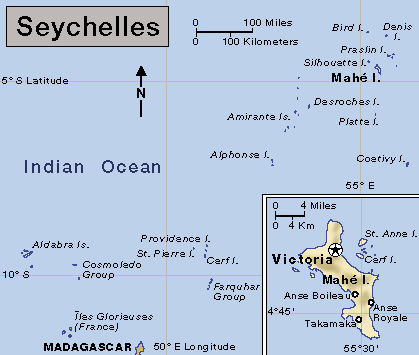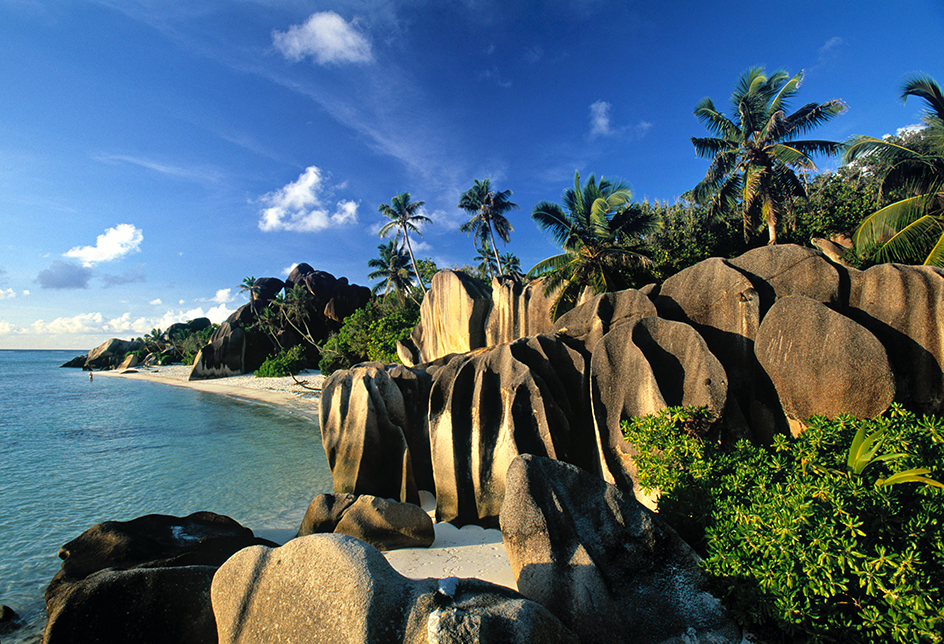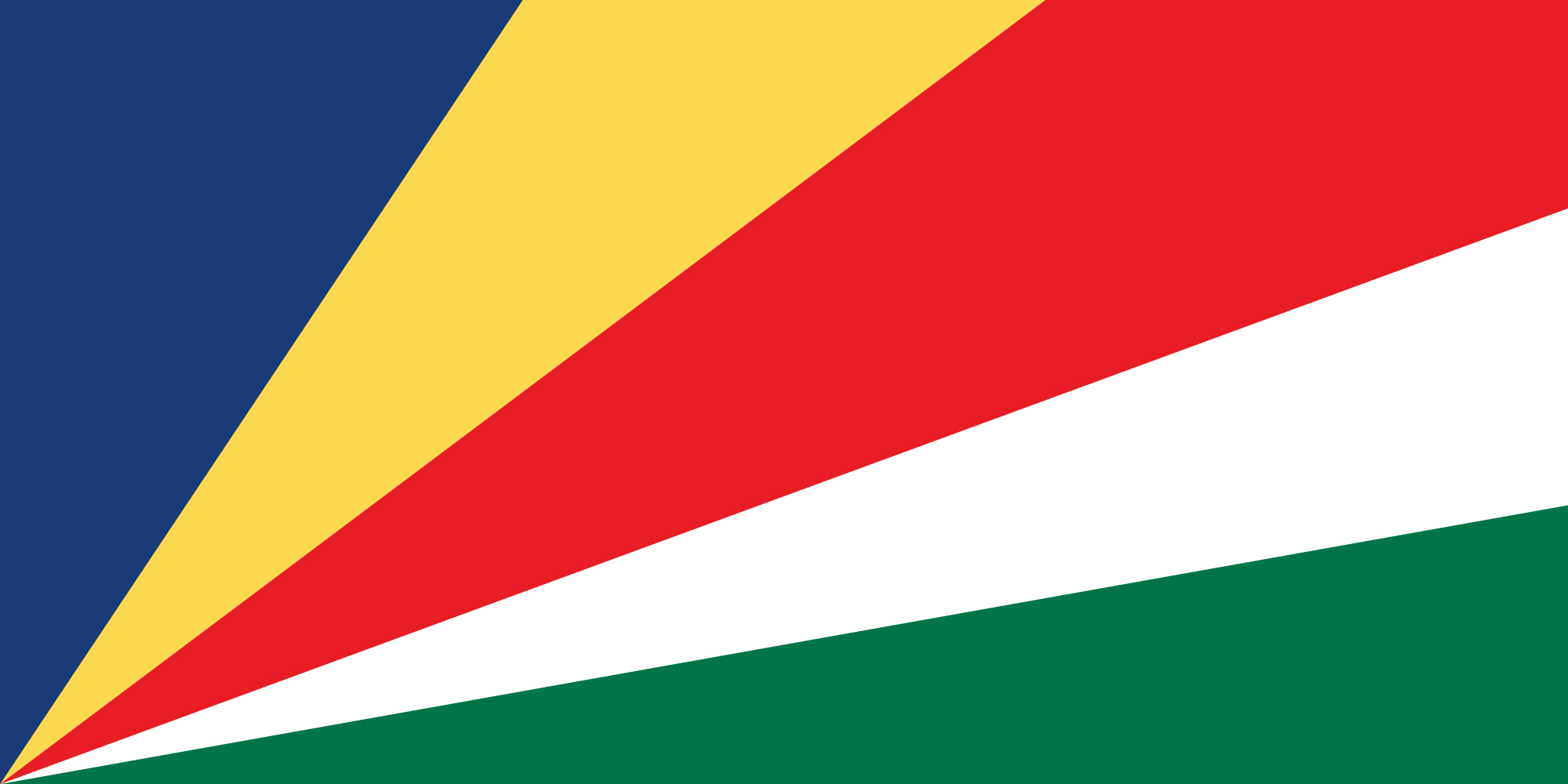Seychelles << say SHEHL or say SHEHLZ >> is an African country that consists of about 115 islands in the Indian Ocean. The islands are scattered over 400,000 square miles (1,000,000 square kilometers). The islands of Seychelles lie south of the equator, about 1,000 miles (1,600 kilometers) east of the African mainland.

Seychelles has a total land area of 176 square miles (455 square kilometers) and a population of about 99,000. The largest island, Mahé, covers 59 square miles (153 square kilometers). More than 85 percent of the people live on Mahé. Most of the rest live on the next largest islands, Praslin and La Digue. Many of the smaller islands are uninhabited. Victoria, on Mahé, is the nation’s capital, chief port, and only major town. It has about 26,000 people. The United Kingdom ruled Seychelles from 1814 until 1976, when it became independent. The country’s basic unit of money is the Seychellois rupee.

Government.
Seychelles is a republic. The people elect a president to a five-year term. The president appoints a cabinet. A National Assembly elected by the voters makes the country’s laws. Assembly members serve five-year terms.
People.
The vast majority of the people of Seychelles have mixed African, Asian, and European ancestry. Some others are descendants of people from China or India. About half of the people live in towns.

Most people speak Creole, which is a dialect of French. The country’s official languages are Creole, English, and French. Most Seychellois are Roman Catholics. Almost all Seychellois children attend school from the ages of 6 to 15. The Seychelles Polytechnic offers advanced vocational training. Most adults can read and write.
Many Seychellois men and women live together without being married, and about half the children are born to unmarried couples. In many cases, the woman provides clothing for herself and the children, and the man buys his own clothes and food for the family.
Land and climate.
Seychelles consists of granite islands and coral islands. The granite islands have streams, mountains, and white, sandy beaches. The soil is fertile. But the land has many rocks, making farming difficult. The coral group is made up of atolls (ring-shaped coral islands) and low islands with reefs that rise a few feet above sea level. These islands cannot support much plant life, and many are uninhabited.
Cinnamon grows wild on much of Mahé, and coconut palms flourish on many of the islands. The coco-de-mer, a double coconut that weighs as much as 50 pounds (23 kilograms), grows only in Seychelles. The country has many unusual species of plants and birds, and giant tortoises also live there.

Seychelles has a hot, moist climate. Annual temperatures average from 75 to 86 °F (24 to 30 °C). The average annual rainfall ranges from 52 inches (132 centimeters) on some of the coral islands to 92 inches (234 centimeters) on Mahé.
Economy
of Seychelles is based on tourism. The country’s remote location and beautiful beaches attract many vacationers. The tourist trade increased the need for hotels and restaurants, which led to the development of a construction industry during the 1970’s.
A shortage of suitable farmland limits agricultural production in Seychelles. Bananas, cinnamon, and coconuts are among the chief crops. Farmers also raise chickens and hogs. Tuna fishing is important to the economy, and canned tuna is the country’s leading export.
The tourism industry and the government are among the country’s main employers. The construction, farming, and manufacturing industries also employ many people.
An airport operates on Mahé. A ferry travels daily among the three largest islands.
History.
Portuguese sailors discovered Seychelles in the early 1500’s. The islands were uninhabited at the time, and for the next 250 years they served chiefly as a hiding place for pirates. In 1742, an expedition from Île de France (now Mauritius) explored Mahé. France claimed the islands in 1756.
About 1770, a group of white planters and enslaved Africans came from Île de France and settled on Mahé. For many years, Seychelles served as a supply station for French ships sailing to India and the East Indies. During the 1790’s, war broke out between France and several European nations, including Great Britain (now also called the United Kingdom). A treaty signed in 1814 gave Seychelles to the British. Conditions on the islands declined under British rule. The United Kingdom did not establish schools there until 1944. During the early 1970’s, many Seychellois began to demand an end to British rule. Seychelles became independent in June 1976.
From 1977 to 2004, France Albert René was the country’s president and most powerful leader. For many years, his Seychelles People’s Progressive Front was the only legal political party. But in the early 1990’s, the Seychelles Constitution was amended to establish a multiparty system. In 2004, René stepped down as president, and his vice president, James Michel, became president. In 2006, Michel was elected to a full term. He was reelected in 2011 and 2015. Michel resigned in 2016, and his vice-president, Danny Faure, became president. In 2020, the people elected Wavel Ramkalawan, head of the Seychelles National Party and leader of the opposition in the National Assembly, as president. He was inaugurated on October 26.
